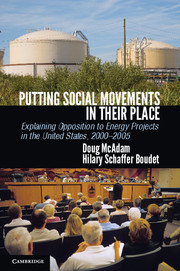 Putting Social Movements in their Place
Putting Social Movements in their Place Book contents
- Frontmatter
- Contents
- Acknowledgments
- 1 From Copernicus to Ptolemy and (Hopefully) Back Again
- 2 Comparing Communities “At Risk” for Mobilization
- 3 Explaining Variation in the Level of Opposition to Energy Projects
- 4 Does Opposition Matter?
- 5 From Not in My Backyard to Not in Anyone’s Backyard
- 6 Back to the Future
- Appendix A Additional Community Data Collected Not Used in Causal and Outcome Condition Scoring
- Appendix B Raw Data and Methods for Scoring Causal Conditions
- Appendix C Interview Sources by Case
- Bibliography
- Index
Appendix B - Raw Data and Methods for Scoring Causal Conditions
Published online by Cambridge University Press: 05 June 2012
- Frontmatter
- Contents
- Acknowledgments
- 1 From Copernicus to Ptolemy and (Hopefully) Back Again
- 2 Comparing Communities “At Risk” for Mobilization
- 3 Explaining Variation in the Level of Opposition to Energy Projects
- 4 Does Opposition Matter?
- 5 From Not in My Backyard to Not in Anyone’s Backyard
- 6 Back to the Future
- Appendix A Additional Community Data Collected Not Used in Causal and Outcome Condition Scoring
- Appendix B Raw Data and Methods for Scoring Causal Conditions
- Appendix C Interview Sources by Case
- Bibliography
- Index
Summary
Generally scores were assigned to quantitative variables corresponding to their percentile value among the twenty communities. Typically, in fuzzy set/Qualitative Comparative Analysis one must designate a point of maximum ambiguity. In this method, the median or 50th percentile is designated as the point of maximum ambiguity. Cases fell in a set for a specific variable if the value of the variable was greater than 0.5. Under this condition the community received a score of 0.6. If the variable value was higher than the 80th percentile, it received a score of 0.8. If the variable value was above the 99th percentile, it received a score of 1. Cases fell out of the set with values of 0.4 if the value was above the 40th percentile and below the 50th percentile, 0.2 if the value was above the 20th percentile and below the 40th percentile, and 0 if the value was below the 20th percentile. Scores were cross-checked against natural break points in the data and typically matched these quite nicely. Some variables (noted in the following text) were assigned scores limited to set membership (1) or nonmembership (0), which reflected if a certain condition was present.
After individual variables were assigned fuzzy scores, they were often combined to form the conceptual causal condition. For example, civic and organizational capacity was constructed using the fuzzy scores for values associated with a community’s general education level, voter turnout rates, and number of nonprofits per capita. Most commonly, we combined these by adding the fuzzy scores assigned to individual variables and then reassigning fuzzy scores to the sum according to the procedure detailed in the preceding text in which scores corresponded to percentile rank.
- Type
- Chapter
- Information
- Putting Social Movements in their PlaceExplaining Opposition to Energy Projects in the United States, 2000–2005, pp. 210 - 231Publisher: Cambridge University PressPrint publication year: 2012


